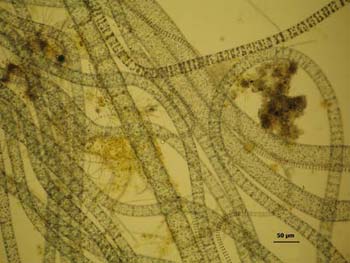Source: Xinhua
02-11-2009 12:39
Special Report: Tech Max |
| The bacteria Thioploca araucae is seen in this undated handout photo. The oceans are teeming with 10 to 100 more types of bacteria than previously believed, many of them unknown, according to a study released on July 31, 2006 that has jolted scientists'' understanding of evolution in the seas.(Xinhua/ Reuters File Photo) |
WASHINGTON, Feb. 10 (Xinhua) -- The genome of a marine bacterium living 2,500 meters below the ocean's surface is providing clues to how life adapts in extreme thermal and chemical gradients, according to an article published in the latest issue of the U.S. journal PLoS Genetics.
The research focused on the bacterium Nautilia profundicola, a microbe that survives near deep-sea hydrothermal vents. Microorganisms that thrive at these geysers on the sea floor must adapt to fluctuations in temperature and oxygen levels, ranging from the hot, sulfide- and heavy metal-laden plume at the vents' outlets to cold seawater in the surrounding region.
The study combined genome analysis with physiological and ecological observations to investigate the importance of one gene in N. profundicola. That gene, called rgy, allows the bacterium to manufacture a protein called reverse gyrase when it encounters extremely hot fluids from the Earth's interior.
Previous studies found the gene only in microorganisms growing in temperatures greater than 80 Celsius degree, but N. profundicola thrives best at much lower temperatures.
"The gene's presence in N. profundicola suggests that it might play a role in the bacterium's ability to survive rapid and frequent temperature fluctuations in its environment," said Assistant Professor of Marine Biosciences Barbara Campbell, the study's lead scientist.
The researchers also uncovered further adaptations to the vent environment, including genes necessary for growth and sensing environmental conditions, and a new route for nitrate assimilation related to how other bacteria use ammonia as an energy source. Photosynthesis cannot occur in the hydrothermal vents' dark environment, where hot, toxic fluids oozing from below the seafloor combine with cold seawater at very high pressures.
These results help to explain how microbes survive near the vents, where conditions are thought to resemble those found on early Earth. Nautilia profundicola contains all the genes necessary for life in conditions widely believed to mimic those in our planet's early biosphere and could aid in understanding of how life evolved.
"It will be an important model system," Campbell said, "for understanding early microbial life on Earth."
-- Click for more news in Tech Max >>
Editor:Yang Jie
